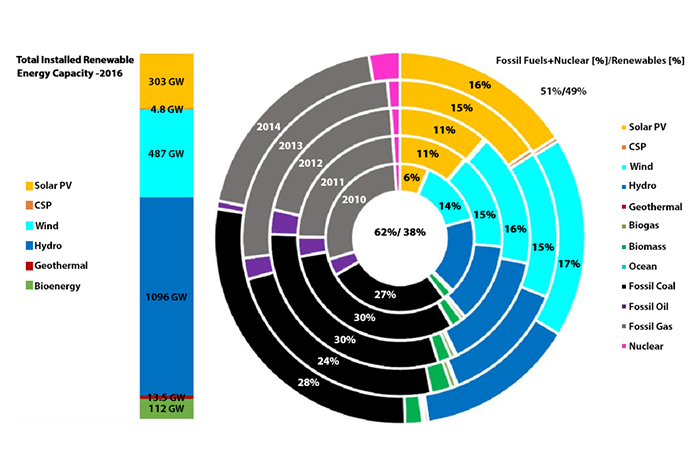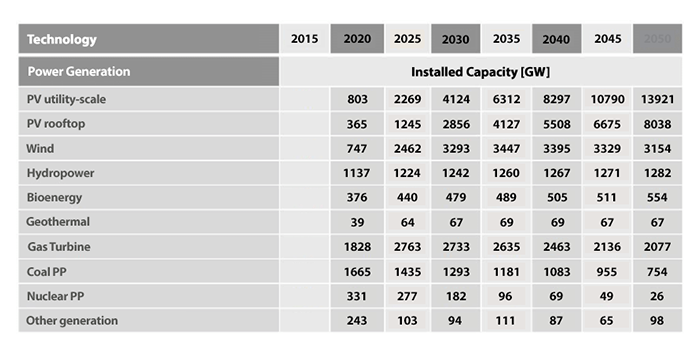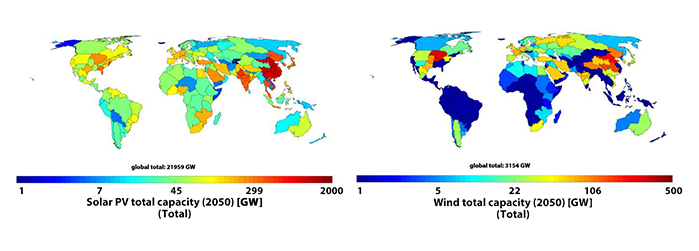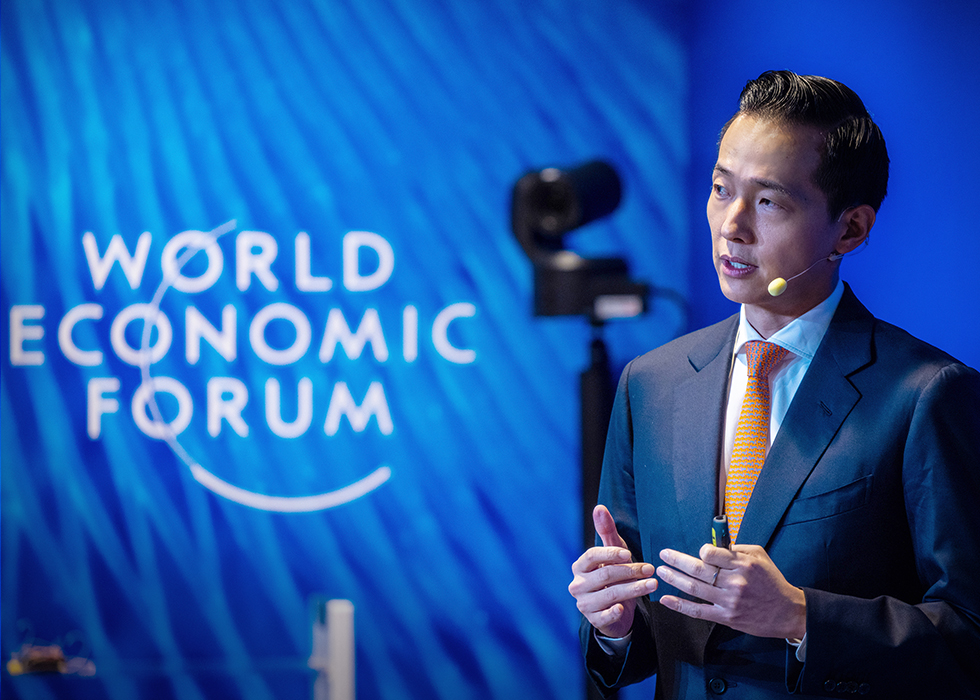The rays that pay: why solar is an unstoppable power source


Solar of 69 : A recent study by Finland’s Lappeenranta University of Technology (LUT) has concluded that a 100% renewable energy power sector is feasible by 2050, with solar PV accounting for 69% of all energy. A bold and optimistic figure, what are the permutations behind reaching that goal?
Christian Breyer, who headed up the research at LUT, outlines the modeling process, describes how solar wins out, and explains why PV will become the lowest-cost, hardest-to-ignore energy source in the very near future - whether politicians or big business like it or not.
Even the harshest, oil-soaked critic of solar power will reluctantly admit that the sun is the basis of all life on the planet. However, this simple fact is one of the main reasons why it has taken so long for solar power to be taken seriously: it is an energy source that is all encompassing, inescapable, inevitable and necessary. It is too big to fail, so why pay it any notice?
The industries that have arisen from harnessing the power of the sun are not solely limited to energy. All farming, agriculture and food production is solar-powered. So is fashion, football and - yes - even the fossil fuel industries. The sun powers everything. That enough solar energy hits the earth in one hour to power the planet for an entire year is one of those well-worn facts repeated by college kids eager to earn an ‘A’ grade on their physics paper.
And it is one reason why photovoltaics (PV) has often failed to grasp the opportunities at play. Solar PV was long considered a niche energy source; an ‘alternative’ to the main pillars of power, namely coal, gas, and nuclear. All the while, anybody and everybody working in the energy sector remained acutely aware that the resources they are dealing in are finite, and such ‘alternatives’ have to be brought into the mainstream at some point.
That point is now. For the past couple of years, solar's record-breaking growth has occurred amid a backdrop of market and political uncertainties, of falling gas and oil prices, and of uneven pricing. Yet in 2017, the world installed 98.9 GW of new PV capacity, according to SolarPower Europe - an annual increase of 29.3% on 2016 (when cumulative solar PV capacity had reached 303 GW; see graph). This figure represents 34% of total new power capacity among conventional and renewable technologies - more than any other - and is a continuation of a worldwide, decades-long upward trend.
 Fig.1: Total installed renewablea energy capacity in 2016 globally (left) and shares of annual power generation technologies installed globally from 2010 to 2014 (right). Source: Lappeenranta University of Technology (LUT)
Fig.1: Total installed renewablea energy capacity in 2016 globally (left) and shares of annual power generation technologies installed globally from 2010 to 2014 (right). Source: Lappeenranta University of Technology (LUT)
Yet despite years of evidence proving that PV always gets cheaper, it always gets better, and it always gains popularity, global analysts entrusted to track and forecast the world’s future energy supply regularly underestimate solar’s potential.
The International Energy Agency (IEA) is a respected organization that publishes regular reports and forecasts on all energy sources, and has many years of data charting just how consistent solar’s rise has been. Indeed, in the latest report published in November 2017 and based on global 2015 data, the IEA found that solar overtook coal in net growth, and along with wind power and other renewables accounted for two-thirds of new power capacity added that year.
By looking back through its data, the IEA could make positive forecasts on solar PV’s future growth. But the IEA remains conservative when it comes to solar.
As an example, because 2017 saw almost 100 GW of PV added, the IEA would essentially expect the same number this year. Even after years of record-breaking installations, the IEA has followed up with reports forecasting lower installations the following year. Even the IEA’s more progressive approach, outlined in its Sustainable Development Scenario, does not exceed 140 GW of new PV capacity per year, despite the fact that annual PV growth has averaged 44% over the past decade. Yet a simple glance at solar development over the course of the last 20 years shows that many forecasts regarding solar out there not only could, but definitely should become more optimistic in order to be realistic.
The IEA is not alone when it comes to conservatively reporting solar’s potential. Following the recent decision by the Chinese government to scale back subsidies and support for its domestic PV industry, GTM Research predicted a 34% decline in module prices for the remainder of 2018. Whether that proves to be accurate or not remains to be seen, but such kneejerk negativity is commonplace in solar.
Which is why the results of the renewable energy modeling study conducted by the Lappeenranta University of Technology (LUT) in Finland triggered a great deal of initial skepticism among even us, the researchers behind the study. The modeling - which is the only one that runs at full hourly resolution around the planet in appropriate spatial resolution - found that solar will account for 69% of the world’s global electricity supply by 2050, with renewables combined meeting 100% of the earth’s power needs.
We were surprised by how high the figure was. It took six months for the team to check the result, and after more than 20 model updates we concluded that whatever we did, 69% kept returning.
And now it is absolutely clear why we get this number.
The LUT model calculates the amount of new power capacity investment required in a least-cost way. It does not say which type of technology should be invested in; rather, it is based on the resource quality of the region. For example, in regions with high levels of solar insolation, PV will likely be a recommended technology.
The model used by LUT divides the world into 145 regions. Real weather data from the year 2005 is used for each region, at one-hourly intervals and 50 km distances around the world. An hourly load curve per region is overlaid with the generation available at each location sufficient to match the load curve. Flexibility options are also taken into account, such as power lines, storage, and dispatchable generation from bioenergy and hydro reservoirs.
Of course, the model considers not only the technical efficiency or technical yield, but also the financial numbers. In other words, it assesses the capital expenditure (Capex) and operational ex penditure (Opex) over the lifetime of the plant, and identifies the least cost solution to cover demand. The existing power plant fleet is still in use throughout the energy transition until the end of technical life is achieved.
The figure of 69% solar coverage is a result of the same modeling process conducted throughout these 145 global regions. The model reaches this penetration figure because, quite simply, at many locations PV makes the most economic sense. Solar growth will take time, but as costs continue to decline, PV learning rates accelerate, and storage technologies keep pace, penetration grows exponentially. By 2030, for example, annual solar installations will be around 500 GW, up from ~ 100 GW today. In contrast, cumulative installed coal capacity will continue to shrink, falling to 1,293 GW by 2030. Gas turbine capacity, on the other hand, will increase for the next decade, before steadily declining as more and more renewable energy capacity is installed (see table below).
 Fig.2: Global - Installed cumulative capacities and net electricity generation by various power sources; installed capacities and net output of various storage sources during the energy transition from 2015 to 2050 at 5-year intervals. Gas turbines transition in fuel use from fossil gas in 2015 to biomethane and power-to-gas in 2050. Source: Lappeenranta University of Technology (LUT)
Fig.2: Global - Installed cumulative capacities and net electricity generation by various power sources; installed capacities and net output of various storage sources during the energy transition from 2015 to 2050 at 5-year intervals. Gas turbines transition in fuel use from fossil gas in 2015 to biomethane and power-to-gas in 2050. Source: Lappeenranta University of Technology (LUT)
The model’s cost starting point is €70/MWh, which includes investment cost, amortization, cost of capital, cost of storage, and all losses relating to transmission and curtailment. This aggregated figure is based on 2015 data, and the model shows gradual price declines through to 2050, at which point solar electricity costs €52/MWh. Basically, by that date, the more solar installed, the lower the cost of the global energy system.
Because this modeling is conducted at hourly resolutions, results are stable. It means that for all hours of the year the model has ensured a sufficient and cheapest energy supply for the demand at any given time resulting in a total PV capacity of about 22 TW in 2050 (see map).
 Fig.3: Major renewable energy capacities in 2050: For an energy system it is important to also know what the weather is doing for any given hour and location. Source: Lappeenranta University of Technology (LUT)
Fig.3: Major renewable energy capacities in 2050: For an energy system it is important to also know what the weather is doing for any given hour and location. Source: Lappeenranta University of Technology (LUT)
In pure numbers, the current 100 GW of new annual PV capacity will have to rise to nearly two terawatts (TW) annually by the middle of the century in order to reach that 69% figure and global spread seen in the map above, and also to meet energy demand in the power and transport sectors.
Those with a vested interest in seeing solar fail will ask: “What about when the sun doesn’t shine?”, and are willfully deaf to the answer: “That’s where affordable storage comes in.” Affordable storage is coming, in a big way. Because it is clear that without substantial support from storage applications we would never see such high levels of solar. Therefore, it is a precondition to have access to low-cost storage in order to get high penetration rates of solar. Otherwise we would see solar reaching its global penetration limit at maybe 20%-30% of the energy system. But with battery storage, 70% is feasible.
Current lithium-ion battery technologies are displaying learning rates comparable to solar, and growth rates that are identical. As with every technology, substantial learning rates coupled with high growth rates deliver rapid cost declines. The main difference right now is that PV is not limited in any way by raw material availability. Things are not so simple with lithium-ion batteries, some of which require cobalt, mined mainly in Congo - a country with an often unstable political and security situation.
As for lithium, the world is sitting on reserves for about the next 20-30 years, which means that, taking into account the LUT model’s projections for storage growth, the industry would have to adopt alternative battery chemistries in the mid-term. The model also assumes that there will be high volumes of battery recycling, which is a must: this needs to be carved in stone.
Solar power is already a vital portion of most leading nations’ renewable energy industries, but penetration rates remain low when placed side-by-side with gas, for example. In Germany, solar meets around 7% of annual electricity demand on average, a figure that rises to 10% in Italy and up to 20% and 25% in California and Hawaii.
With this rising trend, more sophistication in how solar electricity is connected, stored and consumed naturally follows. Batteries, as mentioned, are vital for delivering flexibility to the grid, and solar will soon make an impact on the heating sector. Most heating demand arrives in winter, when evidently solar power is not at its strongest. However, a great deal of 24/7 heating demand comes from the industrial sector - and this is continuous all-year round. There is a substantial heat share that solar - supported by storage - can contribute to, and while the modeling is still being undertaken, it will undoubtedly reach TW scale globally.
Twists and turns are a natural part of the solar industry. Whenever the waters ahead look clear, industry veterans know it is usually time to fasten their lifebelts. Expecting the unexpected is part and parcel for PV, but as the technology builds upon its foundations, a maturing industry will be less susceptible to unforeseen shocks. It will be able to withstand external forces, which makes planning for the future far simpler.
This will not happen overnight. The LUT model is a dispassionate tool that cannot predict future economic crashes, environmental disasters or ill-advised policy decisions. It is not a crystal ball, but it is a most accurate, impartial tool for assessing future energy systems. Hence, with solar winning out as the most scalable, least-cost source of electricity by 2050, the model simply crunches those numbers without comment.
Solar is already beyond or close to grid-parity in many countries. Today and in the future, lobbying efforts by the clean energy industry need to become more sophisticated and engaging if solar is to grab the attention of policy-makers. For this, global leading PV companies should have a much more responsible role to play. When it comes to the global energy transition, multinational companies need to spread the message globally that adopting renewable energy is vital, and beneficial economically and environmentally. ?It is increasingly up to global corporations like Google, IKEA and Hanwha to teach decision-makers what the real-world options for a sustainable energy system really looks like, and to do so in language they understand. In their attempt, they need to be supported by science, environmental movements, health organizations and other social groups. A joint effort is required to fulfill the destiny of solar: to become the cleanest, cheapest and most popular energy source ever known. The time to act is now.

Christian Breyer is Professor for Solar Economy at Lappeenranta University of Technology (LUT), Finland. His major expertise is the integrated research of technological and economic characteristics of renewable energy systems specialising in energy system modeling for 100% renewable energy, on a local but also global scale. His team published the most studies on 100% renewable energy for countries or major regions globally. Publications on negative CO2 emission options gain ground in his team. He worked previously for Reiner Lemoine Institut, Berlin, and Q-Cells (now: Hanwha Q.Cells). He is member of ETIP PV, IEA-PVPS, scientific committee of the EU PVSEC and IRES, chairman for renewable energy at the Energy Watch Group and reviewer for the IPCC.
Get the latest news about Hanwha, right in your inbox.
Fields marked with * are mandatory.
- Non-employee
- Employee




